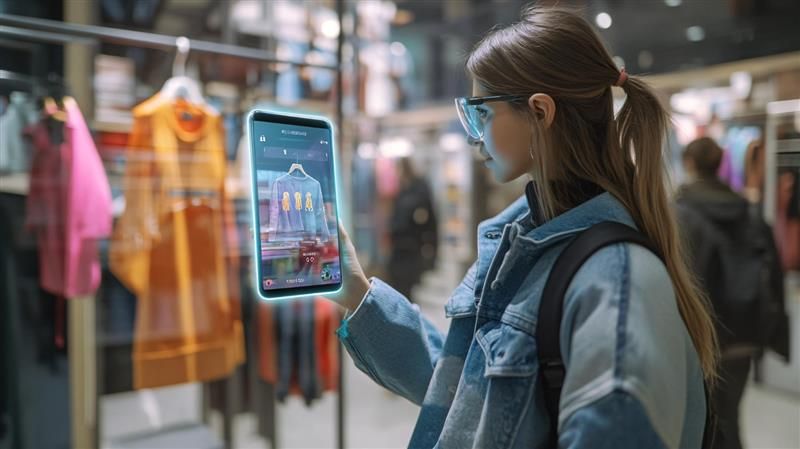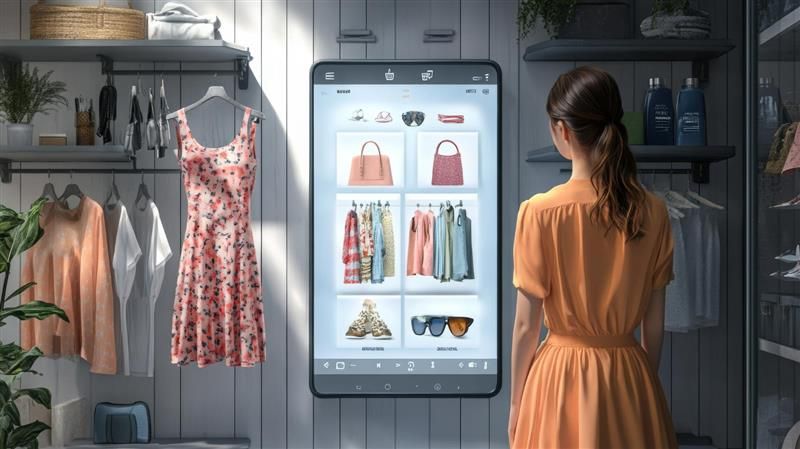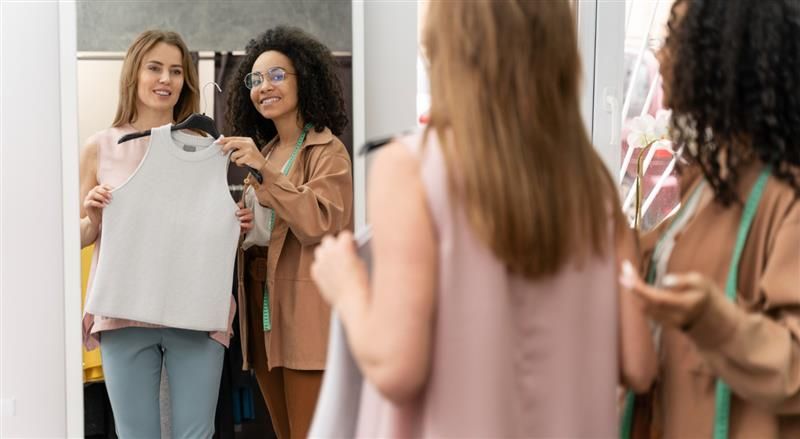Virtual Try-On Technology: Boosting Conversions in Fashion Retail

The fashion industry thrives on personal experience. In physical stores, customers slip into garments, check how they fit, look at themselves from different angles, and often make decisions on the spot. This tactile process builds confidence and reduces hesitation.
E-commerce, however, strips away that interaction. Shoppers can only judge by photos, descriptions, and size charts. As a result, many abandon carts or purchase items that end up returned due to poor fit, style mismatch, or unmet expectations. Studies reveal that more than 30% of fashion e-commerce purchases are returned, with size and fit being the top reasons.
To address this, retailers are turning to virtual try on technology. By allowing customers to digitally try outfits, accessories, and footwear before buying, brands are recreating the store experience online. This not only improves satisfaction but also significantly boosts conversion rates.
What Is Virtual Try-On Technology and How It Works
Virtual try-on technology uses a blend of artificial intelligence, augmented reality, and 3D visualization to simulate how fashion items appear on an individual. It bridges the sensory gap between in-store and online shopping.
Key Components:
- 3D Modeling: Each product is recreated digitally with accurate proportions, colors, and textures. This ensures garments look realistic.
- AI Body Mapping: Using a photo, video, or body scan, AI maps the shopper’s measurements and adapts items accordingly.
- AR Overlays: Augmented reality allows customers to see the product on themselves in real-time via a smartphone camera or mirror device.
How It Works in Practice:
- The shopper uploads a photo or activates their webcam.
- The system analyzes body dimensions using AI.
- The selected item—dress, jacket, or pair of sneakers—is digitally placed on the shopper’s image
- Adjustments in size, movement, and texture replicate how the item would look in reality.
Brands like Gucci, Nike, and ASOS are already using these tools. For instance, Nike’s AR-based foot scan lets buyers check shoe size accuracy, while Gucci offers eyewear try-ons through its app. Some companies also pair these with AI Product Photography to maintain a consistent catalog that fits virtual systems.
Benefits of Virtual Try-On for Retailers and Customers
For Retailers
- Increased Conversion Rates: Shoppers who use try-on tools are far more likely to make a purchase. Research shows conversion lifts of up to 30% for brands with virtual try-on features.
- Fewer Returns: By solving size and fit issues upfront, return rates decline. This reduces logistical costs and improves profitability.
- Stronger Engagement: Customers spend more time on platforms with interactive features, improving the likelihood of upselling.
- Brand Differentiation: Early adopters position themselves as innovative and customer-first, giving them an edge in a crowded market.
- Data Insights: Virtual try-on systems can generate valuable data about customer preferences, which is used for targeted marketing.
For Customers
- Confidence in Fit: AI try on clothes helps buyers visualize products on their unique body shapes. This reduces hesitation.
- Convenience: Trying multiple items instantly online saves time compared to ordering, waiting, and returning.
- Personalization: Many tools suggest sizes or outfits based on past purchases, boosting satisfaction.
- Sustainability: Reduced returns mean fewer shipments and less waste, appealing to eco-conscious consumers.
- Enjoyable Shopping Experience: Trying items virtually feels like a fun, interactive part of the shopping journey.
When both sides benefit—higher conversions for retailers and higher satisfaction for customers—the technology proves its worth.
4. Implementing Virtual Try-On in Fashion E-commerce

Deploying virtual try-on requires both technical investment and strategic planning. Here’s how fashion retailers can implement it effectively:
Step 1: Digitize Your Catalog
Products must be translated into 3D models. Many brands now use AI fashion Product Photography to create consistent visuals that serve as the base for 3D modeling. Every angle and texture must be captured for accuracy.
Step 2: Choose the Right Technology
Options include in-house development, partnerships with tech providers, or e-commerce integrations. A shopify development company can integrate AR-powered try-on apps into online stores, making advanced tools accessible for small and mid-sized retailers.
Step 3: Mobile Optimization
Since most e-commerce traffic comes from mobile, virtual try-on must work smoothly on smartphones. Quick loading, intuitive UI, and one-click access are crucial for adoption.
Step 4: Customer Education
Shoppers must understand how to use the tool. Clear CTAs like “See how it looks on you” or tutorial pop-ups increase engagement. Retailers often showcase demo videos to highlight the feature’s ease.
Step 5: Track Performance
Monitor conversion rates, average order value, and return rates post-implementation. Data helps refine both the tool and the customer journey.
Barriers to Adoption and How to Overcome Them

Despite its benefits, virtual try-on faces several hurdles:
- High Initial Investment: Developing advanced AR/AI systems requires resources. Solution: Start small by offering virtual try-on for specific categories (like shoes or eyewear) and expand gradually.
- Technical Limitations: Loose or layered clothing can be harder to replicate accurately. Solution: Update AI models regularly to improve garment simulations.
- Privacy Concerns: Customers may hesitate to upload photos or scans. Solution: Use transparent policies, encrypt data, and give users control over what’s stored.
- User Experience Challenges: Poor accuracy or lag reduces trust. Solution: Partner with experienced providers and test rigorously.
- Adoption Resistance: Some shoppers may initially ignore the feature. Solution: Combine promotions, discounts, or gamification to encourage first-time use.
As AI development matures, these barriers will shrink, making virtual try-on more accessible for brands of all sizes.
The Future of Virtual Try-On in Fashion Retail
The future of fashion retail lies at the intersection of technology and personalization. Virtual try-on will continue to evolve in exciting ways:
- Metaverse Shopping: Shoppers will enter digital stores, try outfits on avatars identical to themselves, and purchase directly from immersive environments.
- Smart Mirrors in Stores: Physical stores will adopt AR mirrors that allow instant digital try-ons, blending online and offline experiences.
- AI-Driven Outfit Recommendations: Beyond trying individual items, AI try on clothes platforms will suggest complete looks tailored to each customer.
- Social Media Integration: Try-ons will become shareable moments, letting users post how they look in new outfits before purchasing.
- Hyper-Realistic Visualization: As AR and 3D engines mature, garments will move, fold, and stretch digitally with near-real accuracy.
This future will not only boost sales but also redefine how consumers interact with fashion brands.
Conclusion
Fashion retail is moving from static product pages to immersive experiences that inspire confidence and action. Virtual try on technology eliminates a major barrier in online fashion: the inability to test before buying.
For customers, it delivers confidence, personalization, and convenience. For retailers, it means higher conversions, lower returns, and stronger engagement. When combined with innovations like AI Product Photography, digital fitting tools will shape the future of e-commerce.
Brands that work with experienced partners—such as a shopify development company—can implement these features effectively and future-proof their online stores. As AI development advances, virtual try-on will become an essential part of every fashion retailer’s strategy.
The future of fashion commerce belongs to brands that don’t just sell products, but create experiences that inspire buyers to click “buy now.”
FAQs
What is virtual try-on technology in fashion retail?
It’s a digital system using AR, AI, and 3D modeling which gives an idea to shoppers about how clothing or accessories will look on them before buying.How does virtual try-on boost conversions?
By giving shoppers confidence in fit and style, it reduces hesitation, increases purchase rates, and lowers returns.Is this technology only for large retailers?
No. Even small retailers can implement this with the help of a shopify development company and an AI development company that provides cost-effective tools.What role does AI play in virtual try-on?
AI powers body mapping, size accuracy, and outfit recommendations, making the experience realistic and tailored.Can virtual try-on work for all fashion products?
Yes, though accuracy varies. It works best for shoes, eyewear, and fitted apparel. With time, AI will improve its handling of loose or layered garments.
